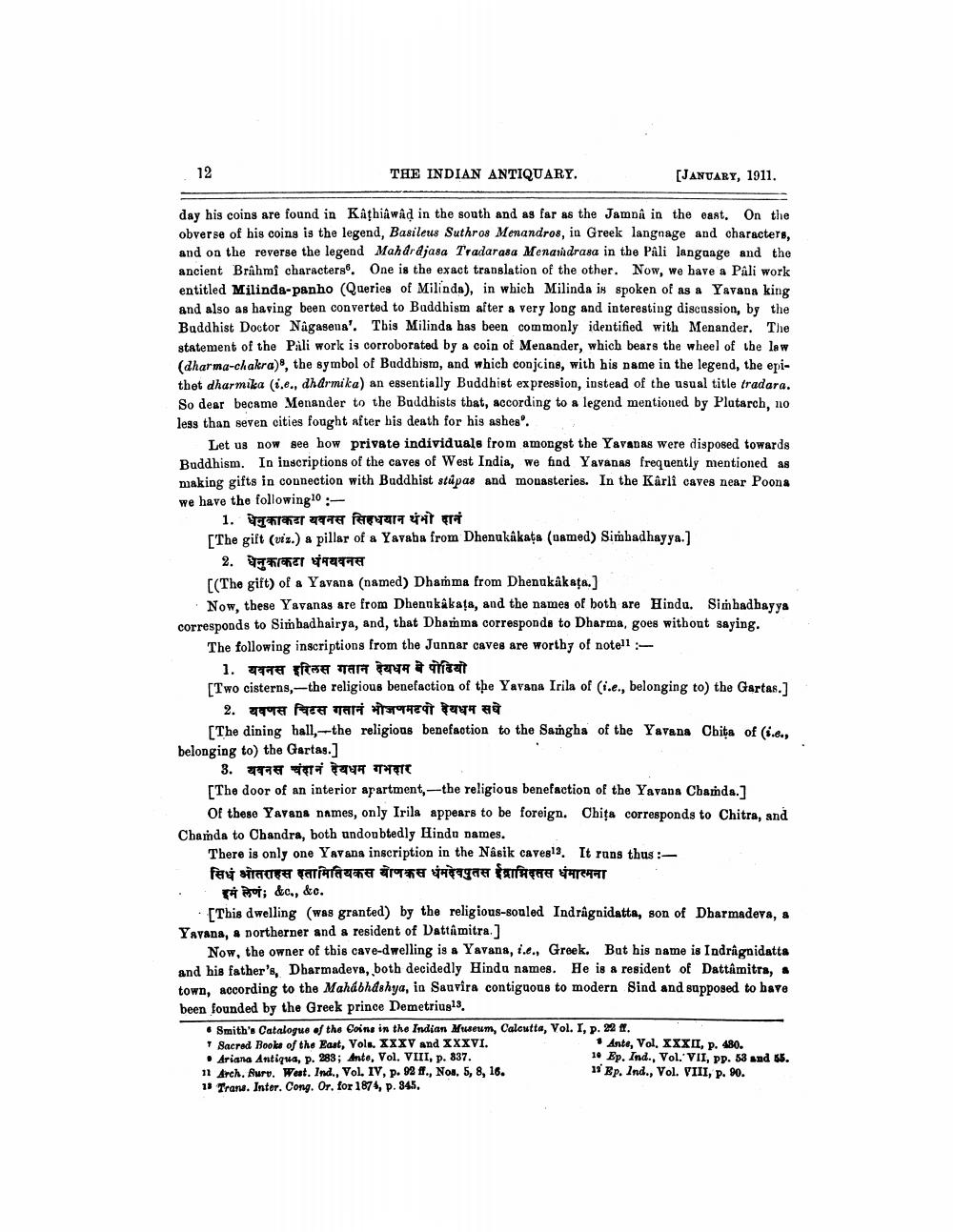________________
12
THE INDIAN ANTIQUARY.
[JANUARY, 1911.
day his coins are found in Kathiâwâd in the south and as far as the Jampa in the east. On the obverse of his coins is the legend, Basileus Suthros Menandros, in Greek langnage and characters, and on the reverse the legend Mahdrdjasa Tradarasa Menandrasa in the Pali langaage and the ancient Brahmi characters. One is the exact translation of the other. Now, we have a Pali work entitled Milinda-panho (Queries of Milinda), in which Milinda is spoken of as a Yavana king and also as having been converted to Buddhism after a very long and interesting discussion, by the Buddhist Doctor Nagasena'. Tbis Milinda has been commonly identified with Menander. The statement of the Pali work is corroborated by a coin of Menander, which bears the wheel of the law (dharma-chakra), the symbol of Buddhism, and which conjcins, with his name in the legend, the epithet dharmika (i.e., dharmika) an essentially Buddhist expression, instead of the usual title tradara. So dear became Menander to the Buddhists that, according to a legend mentioned by Plutarch, no less than seven cities fought after his death for his ashes'.
Let us now see how private individuals from amongst the Yavanas were disposed towards Buddhism. In inscriptions of the caves of West India, we find Yavanas frequently mentioned as making gifts in connection with Buddhist stúpas and mouasteries. In the Karli caves near Poona we have the following! :1.
TE PET * [The gift (viz.) a pillar of a Yavaba from Dhenukakata (named) Simbadhayya.]
2. ET WITH [(The gift) of a Yavana (named) Dhamma from Dhenukákata. · Now, these Yavanas are from Dhennkakata, and the names of both are Hindu. Simhadhayya corresponds to Simbad hairya, and, that Dhamma corresponds to Dharma, goes without saying.
The following inscriptions from the Junnar caves are worthy of notell :
1. यवनस इरिलस गतान देयधम के पोडियो [Two cisterns,--the religious benefaction of the Yavana Irila of (i.e., belonging to the Gartas.]
2. यवणस चिटस गतानं भोजणमटपो देयधम सधे
The dining hall.--the religious benefaction to the Sanghs of the Yavana Obits of (1.c.. belonging to the Gartas.]
3. यवनस चंदानं देयधम गभवार The door of an interior apartment,--the religious benefaction of the Yavana Chamda.
Of theso Yavans names, only Irila appears to be foreign. Chita corresponds to Chitra, and Charnda to Chandra, both undoubtedly Hindu Dames.
There is only one Yavana inscription in the Nâsik caves. It runs thus :सिधं ओतराहस बतामितियकस बोणकस धंमदेवपुतस ईद्राग्निदतस धंमात्मना • ; &c., &c.
This dwelling (was granted) by the religious-souled Indragnidatta, son of Dharmadeva. a Yayana, a northerner and a resident of Dattamitra.]
Now, the owner of this cave-dwelling is a Yavana, i.e., Greek. But his name is Indragnidatta and his father's Dharmadeva, both decidedly Hinda names. He is a resident of Dattamitra, town, according to the Mahabhdshya, in Sauvira contiguous to modern sind and supposed to have been founded by the Greek prince Demetrius,
• Smith's Catalogue of the Coins in the Indian Museum, Calcutta, Vol. I, p. 224. Sacred Booke of the East, Vols. XXXV and XXXVI.
Ante, Vol. XXXII, p. 480. •Ariana Antiqua, p. 283; Ante, Vol. VIII, p. 837.
19 Ep. Ind., Vol. VII, pp. 53 and 55. 11 Arch. Auru. West. Ind., Vol. IV, p. 92 ff., Noa, 5, 8, 16.
11 Ep. Ind., Vol. VIII, p. 90. 11 Trans. Inter. Cong. Or, for 1874, p. 845,




